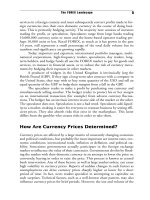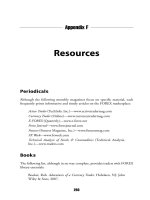Lecture Accounting: What the numbers mean (5/e) - Chapter 16: Cost analysis for decision making
Bạn đang xem bản rút gọn của tài liệu. Xem và tải ngay bản đầy đủ của tài liệu tại đây (157.83 KB, 38 trang )
CHAPTER 16
COST ANALYSIS FOR
DECISION MAKING
McGrawHill/Irwin
©The McGrawHill Companies, Inc., 2002
Learning Objectives
1. What are the meaning and
application of the following “cost”
terms: differential, allocated, sunk,
and opportunity?
2. How are costs determined to be
relevant for short-run decisions?
3. What is the special pricing decision
when a firm is at full vs. idle
capacity?
McGrawHill/Irwin
©The McGrawHill Companies, Inc., 2002
Learning Objectives
4. What are the attributes of capital
budgeting that make it a significantly
different activity from operational
budgeting?
5. Why is present value analysis
appropriate in capital budgeting?
6. What is the concept of the cost of
capital, and why is it used in capital
budgeting?
McGrawHill/Irwin
©The McGrawHill Companies, Inc., 2002
Learning Objectives
7. What are the uses of and differences
between various capital budgeting
techniques: net present value,
present value ratio, and internal rate
of return?
8. How are issues concerning estimates,
income taxes, and the timing of cash
flows and investments treated in the
capital budgeting process?
9. How is the payback period of a capital
expenditure project calculated?
McGrawHill/Irwin
©The McGrawHill Companies, Inc., 2002
Learning Objectives
10. How is the accounting rate of return
of a project calculated, and how can it
be used most appropriately?
11. Why are not all management
decisions make strictly on the basis
of quantitative analysis techniques?
McGrawHill/Irwin
©The McGrawHill Companies, Inc., 2002
Learning Objective 1
• What are the meaning and
application of the following “cost”
terms: differential, allocated,
sunk, and opportunity?
McGrawHill/Irwin
©The McGrawHill Companies, Inc., 2002
Revisit Plans
Strategic,
Operational, and
Financial Planning
Planning and Control Cycle
Performance
Analysis:
Plans vs.
Actual Results
(Controlling)
McGrawHill/Irwin
Implement Plans
Data Collection and
Performance Feedback
Executing
Operational
Activities
(Managing)
©The McGrawHill Companies, Inc., 2002
Cost Classifications for Other
Analytical Purposes
• A differential cost is one that will differ
according to the alternative activity
selected
• Allocated costs are those that have
been assigned to a product or activity
using some sort of arithmetic process
– Do not arbitrarily allocate costs because
costs may not behave the way assumed in
the allocation method
McGrawHill/Irwin
©The McGrawHill Companies, Inc., 2002
Learning Objective 2
• How are costs determined to be
relevant for short-run decisions?
McGrawHill/Irwin
©The McGrawHill Companies, Inc., 2002
Relevant Costs
• Short-run decisions may affect only a
few days or weeks
• Can involve:
– The utilization of resources not otherwise
active
– The opportunity to reduce costs by
adjusting the mix of resources
– The ability to improve profits by further
processing a product
McGrawHill/Irwin
©The McGrawHill Companies, Inc., 2002
Decision Analysis
Classifications
• Relevant costs are:
– Differential costs
– Opportunity costs
• Irrelevant costs are:
– Allocated costs
– Sunk costs
McGrawHill/Irwin
©The McGrawHill Companies, Inc., 2002
Learning Objective 3
• What is the special pricing
decision when a firm is at full
vs. idle capacity?
McGrawHill/Irwin
©The McGrawHill Companies, Inc., 2002
Special Pricing Decision
• Firm is presented with a special offer for their
product below the normal selling price
• Need to know where the firm is operating
relative to capacity
• Need to consider only relevant costs – not
allocated fixed costs
• Also must consider other factor such as affect
on other customers
McGrawHill/Irwin
©The McGrawHill Companies, Inc., 2002
Learning Objective 4
• What are the attributes of capital
budgeting that make it a significantly
different activity from operational
budgeting?
McGrawHill/Irwin
©The McGrawHill Companies, Inc., 2002
Capital Budgeting
• Capital budgeting is the process of
analyzing proposed capital
expenditures
• Capital expenditures are investments in
plant, equipment, new products, etc.
• Want to determine if a large enough
return on the investment can be
generated over time
McGrawHill/Irwin
©The McGrawHill Companies, Inc., 2002
Capital Budgeting vs.
Operational Budgeting
• The time frame being considered is
different – longer – in capital budgeting
• Capital budgeting provides an overall
blueprint to help the firm meet its long-term
growth objectives
• Operational budget reflects firm’s strategic
plans to achieve current period profitability
McGrawHill/Irwin
©The McGrawHill Companies, Inc., 2002
Learning Objective 5
• Why is present value analysis
appropriate in capital budgeting?
McGrawHill/Irwin
©The McGrawHill Companies, Inc., 2002
Investment Decision
Special Considerations
• Investment decisions involve committing financial
resources now in anticipation of a return in the
future
• The time value of money must be considered due
to the length of time involved
• Most firms have more investment opportunities
than resources available
• Capital budgeting procedures help management
identify favorable alternatives
McGrawHill/Irwin
©The McGrawHill Companies, Inc., 2002
Qualitative Factors
• Factors other than quantitative factors also
must be considered
• Must consider things such as competitive
risk, managements’ personal goals, effects
of selling additional stock if necessary
• Usually large expenditures require the
approval of the board of directors
McGrawHill/Irwin
©The McGrawHill Companies, Inc., 2002
Learning Objective 6
• What is the concept of the cost
of capital, and why is it used in
capital budgeting?
McGrawHill/Irwin
©The McGrawHill Companies, Inc., 2002
Cost of Capital
• The cost of capital is the rate of return on
assets that must be earned to permit the
firm to meet its interest obligations and
provide the expected return to owners
• Determining a firm’s cost of capital is a
complex process
• Cost of capital is a composite of borrowing
costs and stockholder dividends and
earnings’ growth potential
McGrawHill/Irwin
©The McGrawHill Companies, Inc., 2002
Discount Rate
• The cost of capital is the discount rate
used to determine the present value of
the investment proposal being analyzed
• The discount rate is the interest rate at
which future period cash flows are
discounted
• Ranges from 10 – 20%
McGrawHill/Irwin
©The McGrawHill Companies, Inc., 2002
Capital Budgeting
Techniques
• Methods that use present value
analysis:
• Net present value (NPV) method
• Internal rate of return (IRR) method
• Methods that do not use present value
analysis:
• Payback method
• Accounting rate of return method
McGrawHill/Irwin
©The McGrawHill Companies, Inc., 2002
Variables Used in Capital
Budgeting Methods
• All methods use the amount to be
invested
• The amount of cash generated by the
investment is used in the NPV, IRR,
and payback methods
• The accounting rate of return uses
accrual accounting net income
resulting from the investment
McGrawHill/Irwin
©The McGrawHill Companies, Inc., 2002
Learning Objective 7
• What are the uses of and
differences between various
capital budgeting techniques: net
present value, present value ratio,
and internal rate of return?
McGrawHill/Irwin
©The McGrawHill Companies, Inc., 2002









